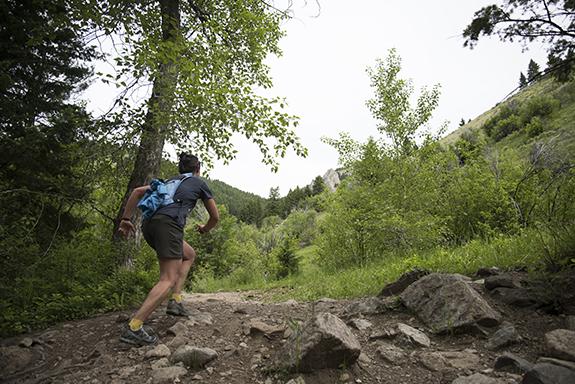Staying Fueled During Exercise
Whether you live in the Gallatin Valley or are just visiting, chances are you’ll take a self-guided excursion into the wilderness sometime soon. Regardless of the season, the outdoor opportunities around here seem limited only by one’s time, fitness, and level of imagination.
Before taking off to summit a craggy peak or slog up a steep singletrack, put some serious thought into what your body will need for energy to fuel your efforts. Unless you know for certain that your trip will last less than an hour, planning ahead to keep your body fueled will serve two purposes: 1) You’ll enjoy the experience much more because your muscles stayed fueled and your blood sugar remained stable (which keeps your brain happy); and 2) In case of an emergency (e.g., twisted ankle, busted bike chain forces you to walk out), you are better equipped to help yourself because you’re not starving as well.
What kind of food should you carry and how much of it? The best type of foods to pack are what I call “functional foods”—commercial foods designed to be consumed during exercise. This includes energy bars, energy gels, and sports drinks. What makes these foods truly functional is that their major ingredients are exactly what you need during extended bouts of exercise AND they are packaged in a manner that is relatively light and easy to carry.
Importance of Carbohydrates
In contrast to the fairly recent hype surrounding low-carb diets, carbohydrates are exactly what should be consumed during exercise. In fact, foods composed of simple sugars are most easily absorbed and utilized by your body during exercise. Functional foods, for example, are usually composed of several types of simple sugars that actually accelerate the rate of absorption over foods composed of only one type of sugar. Some people will also refer to these as high-glycemic index foods because they can cause a rapid increase in blood glucose.
Simple-sugar carbohydrates are most important for fueling your body during exercise because this is the same fuel preferentially used by your muscles. The carbohydrates stored within your muscles, however, will only last a few hours during high-intensity exercise so the food you carry actually helps the muscles from running out of fuel. If your muscles run out of fuel (carbohydrates) during exercise, you are likely to experience what endurance athletes call “The Bonk”—a lack of muscle carbohydrate combined with low blood glucose.
How Much is Enough
Current research suggests two general rules of thumb for fueling yourself during extended bouts of exercise. For shorter duration efforts (less than two hours) at a light to moderate intensity, plan to consume 30-60 grams of carbohydrate per hour. For longer duration efforts, especially when the exercise intensity is moderate to high, the rule of thumb becomes more specific: one gram of carbohydrate per kilogram of body weight (note: 1 kg = 2.2 lbs). A popular energy bar has 45 grams of carbohydrate so one bar per hour is a reasonable rate of consumption at light-to-moderate intensities. Just look on the food packaging to find the quantity of carbohydrate in the food you are interested in taking. (More specific examples about carbohydrate quantities can be found in the sidebar.)
When to Eat
When exercising for more than two hours it would be best to eat according to a plan. This helps prevent eating too much, or too little, at irregular intervals. A good rule of thumb is to eat something every 20-30 minutes while exercising, while keeping to the aforementioned 1g/1kg bodyweight rule.
Putting Principle to Practice
I recently did a 120-mile bike ride through the Gallatin Valley and had planned to fuel my body with an energy gel during the entire ride. Using the 1g/1kg bodyweight rule, I determined that I needed at least three packs of energy gel (25 grams per pack) per hour, which translated to 21 gel packs for a seven-hour ride. For convenience, I carried the gel in two specially-designed flasks to minimize weight and avoid the need to carry extra packaging. It should be noted here that a medium-sized banana has about the same amount of simple carbohydrate as a pack of energy gel—but even a very hungry monkey would shy away from carrying 21 bananas for a seven-hour bicycle ride! Functional foods for exercise may not always be optimally palatable, but their prepackaged form and low weight make them perfect for carrying during exercise. By combining the proper fuel intake with an efficient carrying method, I stayed strong and focused my entire ride.
A great website for more information about nutrition during exercise is sponsored by the Gatorade Sports Science Institute: gssiweb.com.
Dan Heil, Ph.D., FACSM, teaches Exercise Physiology at Montana State University Bozeman. He trains year-round for trail running, triathlon, and cross-country ski races.






